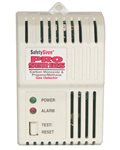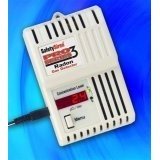- Home
- Carbon Monoxide
- CO Detector
Carbon Monoxide
Detector Information
A carbon monoxide detector is an important part of your defense against carbon monoxide poisoning.
But... please do not neglect regular inspections of your fossil fuel combustion appliances, just because you own a carbon monoxide alarm. Why? Because even low levels of carbon monoxide are a significant health concern.

A CO detector is vital for any household to protect against unforeseen occurrences. For example... a bird building a nest in your flue pipe during a period when the furnace is not being used. Or a vent pipe gets knocked loose in the basement and the combustion gases are now exhausting into your house!
The tables below show the the most recent standards for CO detectors. Notice that they provide different guidelines for the alarm to sound at various CO levels. Why is this done?
To avoid the "boy who cried wolf" syndrome.
We have to live with the fact that some carbon monoxide is present in our homes. If you have gas stove/oven and are cooking the November turkey for 5 hours and with all the burners on, your levels will rise.
A properly adjusted gas range should produce less than 5 ppm of CO. A poorly maintained range may be 5-15 ppm. But these numbers could be higher depending on the duration of the appliances usage.
Cigarette smoke contains CO. Every time the furnace or water heater fires up there is a certain amount of flue gas spillage into the home.
These smaller amounts dissipate quickly and are of no major concern.
Back to the "boy who cried wolf," if your carbon monoxide detector were to sound every time a spike above 30ppm was recorded the homeowner may be inclined to disconnect the unit. So these standards have been designed to warn the home owner of high levels immediately and of longer-term lower levels.
| The UL standard 2034 (1998 revision) | |
|
30 ppm present |
Alarm will sound when present for more than 30 days. |
|
70 ppm present |
Alarm will sound within 1-4 hours. |
|
150 ppm present |
Alarm will sound within 10-50 minutes. |
|
400 ppm present |
Alarm will sound within 4-15 minutes. |
Please notice the the difference between the UL Standard and the European Standard shown below. The EN50291 requires the detector to sound if levels are present above 30ppm in about 2 hours. Where as the UL allows the alarm to sound only after 30 days of continuous readings above 30ppm. Remember... that even low levels of carbon monoxide are a serious threat to our health. Learn more about carbon monoxide symptoms...
| The European Standard - EN50291 | |
|
30 ppm present |
The alarm must not activate for at least 120 minutes |
|
50 ppm present |
The alarm must not activate before 60 minutes but must activate before 90 minutes |
|
100 ppm present |
The alarm must not activate before 10 minutes but must activate before 40 minutes |
|
300 ppm present |
The alarm must activate within 3 minutes |
What to look for when purchasing a carbon monoxide detector...
- Choose a detector with a memory if you want to monitor long term low-level exposure and short term, high-level exposure. Even though product standards do not allow manufacturers to display low levels of CO, these units monitor and store this information. Peak levels, no matter what the level of concentration, can be viewed by pressing a button.
- Battery-operated units allow for carbon monoxide detector placement in the most convenient location. However, any battery-operated device requires the user's diligence in replacing worn-out batteries.
- Do not connect plug-in units to an electrical outlet that is controlled by a wall switch or a GFCI outlet.
- No detectors will operate properly forever. Replace them at least every five years, unless the manufacturer specifies a shorter or longer life.
- Look for models with a test button, which allows you to check the alarm.




New! Comments
Have your say about what you just read! Leave me a comment in the box below.